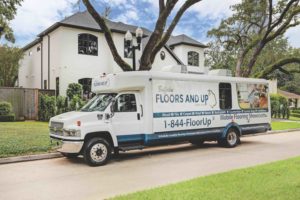
By Rob Persons Today’s mobile showrooms aim to bring the in-store experience to the customer without sacrificing the personal touch. Moreover, the shop-at-home format has helped flooring stores maintain their business during the pandemic, allowing consumers a safer, more comfortable environment for shopping. With shopping from home becoming more the norm than a niche, some predict mobile showrooms will become a requirement—not just an optional extension of the business.
FCNews spoke with several store owners, operators and executives who have had success with mobile showrooms. These include: Jimmy Poulos, founder and president of Flooring 101, which operates seven stores in California; Alfred Soyyar, owner of Texas-based Buffaloe Floors & Up, offering two mobile showrooms with a third on the horizon; Brad Dresbach, chief branding office of Ohio-based America’s Floor Source (AFS), which runs 20 mobile showrooms across three states; and Brian Peed, co-owner of Lexington, S.C.-based retailer, The Floor Boys, which currently has five mobile showrooms but plans to add 15 more in the next two years.
Following are some tried-and-true tips for setting up your own successful shop-at-home business.
Tip #1: Maximize your time in the customer’s home
The mobile showroom format offers convenience for both the homeowner and the salesperson. On one hand, the consumer can try out many samples all in one trip. Meanwhile, the RSA can tailor his or her approach to the unique needs of the client without distractions. But it’s still vital that RSAs use their time efficiently. “The close rate of selling anything when the person has invited you into the house is great,” AFS’ Dresbach said. The downside is, he noted, that salesperson will only see three to five clients in a day. That means each visit needs to be productive.
So, how is that productivity measured? By integrating a mobile showroom program with lead management software. “If you are sending a salesperson off to spend an entire day with only a handful of clients, it is critical that managers employ the tools to track the progress of those leads to determine if it’s an efficient use of time and resources,” Dresbach said. “In the event of a positive outcome, the advisor can then leverage technology to track material shipments and schedule the installation.”
Other experts, including Flooring 101’s Poulos, suggested RSAs get a better feel for what the customer is looking for prior to the appointment. “This way, you’re customizing what’s in the van before you make that sales call,” he said.
Tip #2: Develop standard operating procedures
Making sure RSAs fully understand how the entire shop-at-home operation works is key. For Buffaloe’s Soyyar, working with his salespeople to establish the operational methods has been instrumental. “We have employees who have been with us for decades who have done it all, so drawing from that knowledge is huge,” he explained.
Tip #3: Get the customer to commit
Much like sealing the deal with a customer who visits a brick-and-mortar flooring store, it’s just as important to close the deal with the shop-at-home client. “You have to be a good closer because you don’t want to have to go back to her home a second time,” Flooring 101’s Poulos said. “You want to close the sale the first time you get into the home. Otherwise, if you go there and leave, you will not succeed.”

The key to sealing the deal, Poulos added, is creating a sense of urgency. “You can say, ‘By the way, we have a 25% discount for all shop-at-home products. You’re not going to find the same deal in the store.’”
Tip #4: Invest in transportation, infrastructure
Having an impactful mobile showroom goes well beyond sporting a nice set of wheels—although that’s a big part of it. Success also entails investing wisely in the infrastructure necessary to operate a properly functioning shop-at-home business.
Buffaloe Floors & Up’s Soyyar stressed the importance of having the combination of installers, warehousing capabilities and project management systems in place to execute effectively. “Don’t think you can just grab some samples, throw them in a vehicle and say you have a mobile showroom,” The Floor Boys’ Peed said. “Be prepared to spend $40-$50K and hire a professional.”
A big part of that means investing in a working vehicle that also looks good when you pull into the customer’s driveway. America’s Floor Source and The Floor Boys use Mercedes Benz Sprinter vans while Buffaloe Floors & Up opts for shuttle buses. To pick the best one for your specific needs, ask questions like: How should the samples be displayed? What amenities should be available?
Whichever mode of transport you do choose, it is essential that it does not require a specialized CDL license and that your employees feel comfortable driving it, experts added.
Tip #5: Enlist a point person to manage the operation
Having one person in charge of running the shop-at-home business is a good idea. This ensures uniformity across the customer experience. “You need to have somebody who makes and controls the appointments for the shop-at-home salesperson,” Flooring 101’s Poulos said. “The salesperson doesn’t do it himself. You say, ‘Hey, you have an hour appointment here, you have another hour appointment there.’ The manager controls the appointments.”
Tip #6: Be flexible in your approach
Virtually all the experts FCNews interviewed said they are constantly evolving their approach to maintaining a profitable shop-at-home business. AFS’ Dresbach, for instance, said he and his colleagues constantly refine which samples are included, then tinker with the operational procedure.
That’s something Flooring 101’s Poulos said he closely watches. Here’s his advice: “Minimize the amount of product you have in the van. If a collection has 20 SKUs, bring five of the best colors you know will sell. That way, you have strong knowledge of everything you have in the van.”

